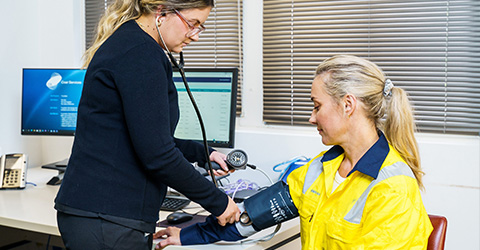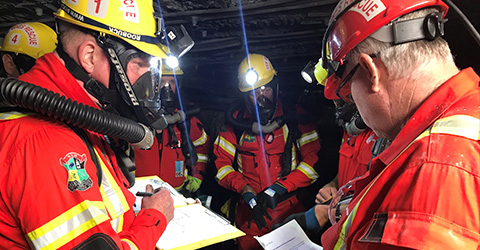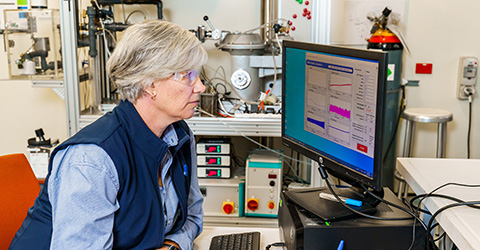Integration of real-time low-cost particulate matter sensors into coal mining air quality management to identify sources and reduce hazardous exposure
Expected results:
- Define the necessary features of a low-cost sensor (LCS) monitoring system to be implemented on an open-cut mine site in the Upper Hunter;
- Increase the coverage of dust emissions measurement to a greater number of locations and activities in real-time, significantly enhancing and improving the existing practice of relying on human observation and measurements from a few boundary monitors e.g. a sensor could be placed on a haul truck to monitor the dust and inform the operator; and
- Demonstrate that a real-time measurement system that is much cheaper compared to standard reference methods, complements existing regulatory dust measurement, improves effectiveness of mitigation and promotes extension of tenure.
Overall, the pathway from building a prototype LCS unit and array, advancing to a pilot scale trial and implementing in practice in an industrial full-scale field-testing environment is relatively clear. The expected outcomes are three-fold and include:
- Reducing exposure to protect coal mining personnel,
- Reducing downtime due to enforced ceasing of operations and
- Decreasing impact on the surrounding mining communities and the environment.
Ref Number 20657
Dr Dusan Ilic The University of Newcastle
Start date
End date
Diesel-free environment for underground coal mines
Expected results:
- Realisation of diesel-free vehicles for mining occupations. This will be a low speed battery powered vehicle that is explosion protected and designed for the important task of transporting both personnel and materials in underground coal mines.
- A reference of pioneer vehicle that can be referred to establish other mining vehicles or mobile machines that range from low to high power requirements. Likewise, a standard evaluation procedures for all high energy density battery chemistries for applications in underground coal mining will be available.
- A wireless charging technology that will be highly versatile in mining occupations since the evolution of electric-powered machinery in underground mines has become ever-increasing to meet the growing emissions, health and energy efficiency concerns.
Note: Project considered no longer viable. Project terminated.
Ref Number 20637
Khay See University of Wollongong
Start date
End date
System demonstrator of a portable NIR spectrometer for rapid stone dust compliance testing
Expected results:
At the end of the project, an expected benefit is to prove the viability of current NIR sensors as a viable option for use within Australian coal mines for rapid stone dust compliance testing.
- The outcome of this trial will enable the future development of a handheld sensor for Australian coal mines. The next stage of research and development beyond this project will be to design the unit into an intrinsically safe prototype.
- Additionally, it will provide the resource industry with further research results into portable and micro spectrometers and their increasing viability for specified applications, such as active coal quality monitoring, gas analysis and other specific spectral sensing applications within the mining industry.
Ref Number 20663
Dr Sebastian D’Hyon Senior Scientist - SIMTARS Queensland
Start date
End date
Optimisation and pilot development of pneumoconiosis detection software
Expected results:
- Collected at least 500 chest x-rays with different categories of positive ILOs.
- Evaluated our automated pneumoconiosis detection tool’s sensitivity and specificity using these additional data. Made necessary modification to the design of the tool, if needed.
- Developed, trained, and evaluated an automated pneumoconiosis classification tool using the additionally collected data and synthetic images learnt from the real X-ray image data. Such a tool is able to predict an ILO Classification System based category of severity of pneumoconiosis, and, possibly, the correct shape and size of parenchymal opacities that are main signs of pneumoconiosis in chest x-rays.
- Developed a user-friendly front end to the detection and classification tools and delivered the software to CSH. This pilot software is used retrospectively on 5% of images routinely collected by CSH and evaluated against expert radiologists’ examination results. The feedback from the pilot study will be used to further improve functionality and performance of our automated tools
Ref Number 20656
Dr Dadong Wang CSIRO
Start date
End date
Resilience and Mental Health in Mining
Expected results:
This study will provide evidence on the current practices and policies that facilitate (or undermine) resilience and positive mental health in the Coal Mining industry. It will provide information on the factors that support resilience at work as well as initiatives that been trialled, how these have been perceived by employees and what outcomes have been achieved. By the end of the project, we expect to:
- Have comprehensive evidence on individual resilience in the NSW coal mining industry and the organizational factors that contribute to resilience and positive mental health in coal mining as well as those that contribute to psychological distress.
- Understand the impact of organizational, workplace and personal support factors on resilience and positive mental health in coal mining. This valuable information will allow industry to identify which organisational and workplace programs will promote mental health.
- Have developed a mental health promotion model which identifies policies and practices that support resilience in mining. This will inform the implementation of appropriate programs with a shift from an ad-hoc approach to the engagement of key stakeholders in the development of a well-evidenced, industry-wide approach to the promotion of resilience and positive mental health.
Ref Number 20655
Professor Rebecca Mitchell Macquarie University
Start date
End date
Evaluation and optimisation of the performance of water spray dust suppression technology within the coal mining industry
Expected results:
The main outcomes will be the identification of critical properties/factors that should be measured at a mine site and the development of a set of relationships so that nozzle design/positioning, spray properties, etc. can be matched correctly to the dust and on-site conditions for a specific location, so that dust suppression (dust control) efficiency can be maximised.
This will provide the industry with best practice guidelines and allow for a more accurate engineering approach to the design and application of water spraying dust suppression systems in coal mines (with minimal water consumption).
Properties studied including dust particle size distribution, dust concentration, particle composition (via sampling), air velocity, droplet size distribution, droplet concentration, droplet velocity and spray flow rate (water usage) will become part of a database of information that can be used as reference material in future design guidelines.
Ref Number 20653
Dr David Hastie Senior Lecturer - University of Wollongong
Start date
End date
Obesity and coal mining: pilot intervention
Expected results:
This research will provide valuable information for organisations about the challenges and benefits of introducing and implementing a healthy weight framework and initiative into the workplace.
This project has anticipated outcomes of a reduction in weight at the individual level, but importantly the project is about mine site ownership and engagement in the entire RESHAPE process. The process involves consultation with employees and selecting interventions that best-fit the workforce and site needs is necessary to ensure sustainability.
Attention must also be given to embedding this practice into health and safety organisation policy. There are also subsequent health benefits of a healthier workforce at the company level and overflow benefits to family and coal mining communities. The literature indicates a reduction in prevalence of overweight and obesity would lead to significant social and economic benefits for individuals, the community and the workplace.
Research results include dissemination of findings at a mine level, in academic peer reviewed journals and at appropriate industry relevant conferences.
Ref Number 20650
Associate Professor Carole James University of Newcastle
Start date
End date
Characterising the biological effects of particulate matter exposures in coal mining to protect and improve the health of workers
Expected results:
At present, it is not clear how the existing standards for safe workplace exposure to coal dust have been generated, with the literature and the evidence upon which they are based pre-dating current mining practices. The advancement of coal technology, from the coalface to techniques of preparation, has not been replicated and/or complemented by a consistent development of supporting guidelines for safe exposures to PM along the handling and transportation chain.
It is unknown if Workplace Health and Safety (WHS) protocols appropriately incorporate the levels of exposure to different types of coal dust (e.g. fines and tailings). Coal dust type will differ (e.g. chemical elements and compounds) due to coal seam composition variation and mining method (e.g. long wall vs open-cut mining). Coal dust type will also have different levels of effects on respiratory health, depending on the dust constituent properties, concentration and duration of exposure.
We will address these important issues and define improved, evidence-based standards for safe exposure to different types of coal dust in Australian mining sites and transport and handling corridors. We will do this by characterising the biological and health effects of exposures to different types and levels of coal dust found in the workplace, from the mining source to the port and including all handling and transportation operations, with the goal of informing new regulations for re-defining risk, early identification of effects and safe PM exposures for coal and associated workers.
Ref Number 20649
Professor Phillip Hansbro University of Newcastle
End date
Share this page






